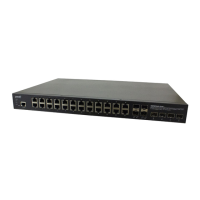Lantronix SISPM1040-xxxx-L3 Web User Guide
33856 Rev. A https://www.lantronix.com/ 22
DHCPv6 Rapid Commit: Enable the DHCPv6 Rapid-Commit option by checking this box. If this option is
enabled, the DHCPv6 client terminates the waiting process as soon as a Reply message with a Rapid Commit
option is received. This option is only manageable when DHCPv6 client is enabled.
DHCPv6 Current Lease: For DHCPv6 interface with an active lease, this column shows the interface address
provided by the DHCPv6 server.
IPv6 Address: The IPv6 address of the interface. A IPv6 address is in 128-bit records represented as eight fields
of up to four hexadecimal digits with a colon separating each field (:). For example, fe80::215:c5ff:fe03:4dc7.
The symbol :: is a special syntax that can be used as a shorthand way of representing multiple 16-bit groups of
contiguous zeros; but it can appear only once. The system accepts a valid IPv6 unicast address only, except
IPv4-compatible addresses and IPv4-Mapped addresses. The field may be left blank if IPv6 operation on the
interface is not desired.
IPv6 Mask: The IPv6 network mask, in number of bits (prefix length). Valid values are 1-128 bits for a IPv6
address. The field may be left blank if IPv6 operation on the interface is not desired.
Resolving IPv6 DAD: The link-local address is formed from an interface identifier based on the hardware
address which is supposed to be uniquely assigned. Once the DAD (Duplicate Address Detection) detects the
address duplication, the operation on the interface SHOULD be disabled. At this moment, manual intervention is
required to resolve the address duplication. For example, check whether the loop occurs in the VLAN or there is
indeed other device occupying the same hardware address as the device in the VLAN.
After making sure the specific link-local address is unique on the IPv6 link in use, delete and then add the specific
IPv6 interface to restart the IPv6 operations on this interface.
Link-Local Address binding interface: Configure Link-Local IP address to a different VLAN interface. The first
IP interface entry (VLAN1) is the default value.
IP Routes
Delete: Select this option to delete an existing IP route.
Network: The destination IP network or host address of this route. Valid format is dotted decimal notation or a
valid IPv6 notation. A default route can use the value 0.0.0.0 or IPv6 :: notation.
Mask Length: The destination IP network or host mask, in number of bits (prefix length). It defines how much of a
network address that must match in order to qualify for this route. Valid values are 0-32 bits for IPv4 routes or
128 bits for IPv6 routes. Only a default route will have a mask length of 0 (as it will match anything).
Gateway: The IP address of the IP gateway. Valid format is dotted decimal notation or a valid IPv6 notation.
Gateway and Network must be of the same type.
Next Hop VLAN (Only for IPv6): The VLAN ID (VID) of the specific IPv6 interface associated with the gateway.
The given VID ranges from 1 to 4095 and will be effective only when the corresponding IPv6 interface is valid.
If the IPv6 gateway address is link-local, it must specify the next hop VLAN for the gateway.
If the IPv6 gateway address is not link-local, system ignores the next hop VLAN for the gateway.
Distance: The distance value of the route entry is used to provide the priority information of the routing protocols
to routers. When two or more different routing protocols are involved and have the same destination, the distance
value can be used to select the best path.
Buttons
Add Interface: Click to add a new IP interface. A maximum of 128 interfaces is supported.
Add Route: Click to add a new IP route. A maximum of 128 routes is supported.
Apply: Click to save changes.
Reset: Click to undo any changes made locally and revert to previously saved values.
Messages:
DHCP Per Port IP range (192.168.1.70 - 192.168.1.77) includes interface IP address (192.168.1.77)
DHCP Per Port IP range (192.168.1.90 - 192.168.1.99) is not equal to switch TP port number (24)

